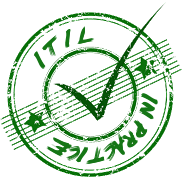

If you are a Project Manager working in an IT environment, you may have heard the acronym ITIL® (IT Infrastructure Library, a set of books similar in nature to PMI's PMBOK Guide) or ITSM (IT Service Management - the concept of IT as a "service" to the business). If you haven't heard of ITIL, you will. Why? Simply put: in terms of industry adoption, ITIL is one of the fastest growing frameworks in the IT industry today.
ITIL helps organizations increase IT efficiency, improve quality, and control costs. In fact, AMR Research reports that IT organizations that have implemented ITIL best practices have saved up to 10% in IT costs without sacrificing the quality of service delivery. That is why U.S. Computer Economics has projected that approximately 45% of all organizations, both large and small, in the US and Canada will have adopted ITIL best practices in some form by the end of 2008.
High Demand for ITIL Expertise
Companies are turning to ITIL, and the demand for individuals with skills and expertise in this area is increasing. So much so, in fact, that ITIL certifications rank as some of the highest paid certifications in technology, along with PMI's CAPM and PMP credentials. In recent salary surveys from ZDNet's Tech Republic, PMI and ITIL credentials consistently rank in the top three IT certifications industry wide. With ITIL's continued growth in the United States, the demand for IT Project Managers with expertise in ITIL will continue.
Focus is on Process, not Technology
The most compelling and interesting similarity between PMI's PMBOK Guide and the ITIL books is that both are descriptive frameworks centered around process, not technology.
What this means to you is that both are extremely approachable standards. For example, the PMP exam does not ask how you would go about creating a milestone task within Microsoft Project. Rather, it makes sure you understand the importance of creating milestones.
The ITIL books are the same way. In order to really understand IT Service Management as a practice, you do not need to understand servers or switches. Rather, you need to understand things like the importance of controlling change, defining service levels, and maintaining a catalog of all your services to the business in terms the business can understand.
Both are bodies of knowledge covering simple principles that are drawn from deep industry experience. They both detail concepts that are scalable and adaptable to each organization. For example, the Project Plan for a small, simple project is going to look very different for a large, complex one. In the same way, the process for managing a minor software patch release is going to have a different scale of requirements compared to a brand new, enterprise-wide software release.
Frameworks on a Similar Mission
In the PMBOK Guide, the goal is to provide project results, on-time and under budget, that meet the needs of the customer. In the ITIL best practice set, the goal is to provide IT "services" that provide value to the business in an ongoing and cost efficient manner.
Both the PMBOK Guide and ITIL guidance have the same mission, to elevate the profession by adding structure and rigor around what is done. Both strive to create a common language and deliver predictable results in a repeatable manner.
For example, in projects, there is a tendency to compress planning and/or testing under the pressure of an aggressive timeline. However, a good project manager knows the importance of planning to alleviate rework later.
In the same way, businesses want IT to be agile and quick to make changes, while avoiding unforeseen consequences. This is done by putting processes in place to prevent unauthorized changes to the IT infrastructure. By having the discipline to develop and follow a formal Change Management process, IT organizations can handle more changes and lessen the risk to the production environment.
My Own Experience
I found ITIL to be a great compliment to my project management skill set as it covers topics in Change Management, Knowledge Management, etc. I really wished I had become certified when I first got involved in technology as it would have set me up with an understanding of how IT processes work (or should ideally work) and would have allowed me to better "speak the language" early on with others in IT.
Getting certified has also given me a greater appreciation of the importance of effective Service Management. I would highly recommend that other Project Managers working in (or with) technology look into ITIL certification as a way to compliment the PMP. In today's competitive market, it sets you apart from the pack and provides you with an expanded toolset for successfully managing projects.
Erika Flora, PMP, ITIL Expert
Principal, Beyond20
About Erika Flora;
Erika is PMP certified as well as MS Project / Project Server Black Belt certified through IIL and Microsoft and holds an ITIL Expert certificate. She is a skilled writer and presenter on a variety of technical and business topics. Erika is also active in the community and currently serves as President of ITSMF's San Diego Local Interest Group (LIG). She has also served on the boards of PMI San Diego and Phoenix and was voted "Volunteer of the Year" by PMI International in 2007
Copyright 2006-2010 Beyond20, LLC, all rights reserved